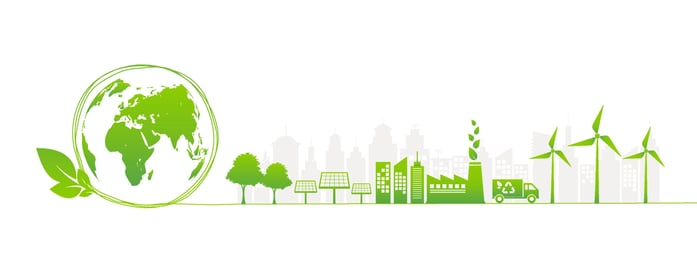As the world continues to grapple with the impacts of climate change, the need for sustainable business practices has become increasingly urgent. Consumers and investors are demanding that companies take concrete steps to reduce their environmental impact and create a more sustainable future. For many businesses, this means developing a sustainability roadmap – a strategic plan that outlines the steps necessary to achieve sustainable operations.
In this blog post, we’ll show you how to develop your sustainability strategy with a sustainability roadmap, helping your business meet its sustainability goals.
What is a sustainability roadmap?
A sustainability roadmap is a strategic plan or long-term vision, that guides an organization to achieve its sustainability objectives.
The roadmap consists of projects, activities, and initiatives that will be the plan for how to realize the sustainability strategy. It helps organizations to:
- define and implement their sustainability strategies
- recognize sustainability risks and opportunities
- identify actions
- measure their progress
A sustainability roadmap gives you an opportunity to engage your employees and stakeholders in creating a vision and plan for how your company can improve its environmental performance and create healthy spaces for your people.
Your sustainability roadmap will be a living document that will evolve over time - a flexible tool that enables organizations to modify their strategies according to external and internal changes.

Why is a sustainability roadmap important?
A sustainability roadmap is important because it fully develops your sustainability strategy, translating a sustainability vision into an action plan. Sustainability can be a complex concept, and organizations need to break it down into tangible goals and actions. Your business will have many moving parts and you will need to work with a whole host of other people and companies that have their own priorities and ways of working.
A roadmap enables organizations to identify sustainability opportunities and challenges, prioritize actions, allocate resources, and track progress against targets. A sustainability roadmap helps organizations to build a business case for sustainability by demonstrating the financial, environmental, and social benefits of sustainability practice.
What's included in a sustainability roadmap?
Every organization uses resources and energy differently, but a few common goals include: to minimize their waste and reduce carbon emissions. A robust sustainability strategy requires a strong foundation and a clear understanding of internal and external operating environments.
Business factors that influence sustainability priorities include investors, customers, resource shortages, consumer preferences, the ROI of projects, regulations, employee morale, recruitment and retention, and brand equity. All of these need to be taken into account in your sustainability strategy, tactics and prioritization of initiatives.
Tips for effective sustainability roadmapping
To create an effective sustainability roadmap, here are some tips to consider:
- Involve key stakeholders, including internal and external groups, in the process to gain buy-in and ownership.
- Use real time data to inform decision-making and track progress.
- Prioritize actions based on their feasibility and potential impact.
- Set SMART (Specific, Measurable, Achievable, Relevant, and Time-bound) targets and regularly review progress against them.
- Communicate progress internally and externally to build awareness and engagement.
- Continuously update the sustainability roadmap to align with changing internal and external circumstances.
6 steps to create a sustainability roadmap
Sustainability is not a one-person job. Your sustainability roadmap should include the input and involvement of key stakeholders across your organization. This might include your employees, customers, investors, and suppliers. Collaborating with these stakeholders can help your business identify new opportunities to reduce its environmental impact and build a more sustainable future.
-
Get an Executive Buy-In
A sustainable roadmap development starts with the championing of the initiative by senior executives. Organizations that have already made headways in sustainability have seen that obtaining an executive buy-in is essential. The senior executives are the face of the organization and can create the necessary momentum that often influences the success of sustainability initiatives. Before commencement, ensure that the top management is committed to creating a sustainability roadmap.
-
Define your goals
Your aspirations and goals for sustainability should align with the company's mission and vision. The next step in developing a sustainability roadmap is to clearly define your objectives.
- What does sustainability look like for your business?
- What are your long and short-term sustainability goals?
To answer these questions, you should engage with stakeholders across your organization, from employees to investors. Consider conducting a sustainability audit or a SWOT analysis to identify areas where your business can improve its sustainability practices. -
Identify key performance indicators (KPIs)
Next, you’ll need to select the KPIs that will track your progress towards your sustainability goals. KPIs should be specific, measurable, achievable, relevant, and time-bound (SMART). Consider factors like energy consumption, waste reduction, carbon emissions, and water usage when selecting your KPIs. By accurately quantifying and analyzing your current sustainability performance, you can identify the areas that need improvement, set benchmarks, and track your progress over time.
-
Develop a roadmap
Once you have your goals and KPIs, it’s time to develop a roadmap that will help you achieve your sustainability objectives. Developing a sustainability roadmap involves identifying the programs, policies, and initiatives your business will take to reduce its environmental impact. These might include investing in renewable energy, reducing waste, and improving supply chain sustainability. Be sure to prioritize the actions that will have the greatest impact on your sustainability goals.
Construct a draft, and then get feedback from key decision-makers, functional leaders, and other stakeholders in the organization. You should release every roadmap version with a set of tangible strategies and targets.
-
Communicate and execute the sustainability roadmap
Launch the sustainability roadmap with a detailed rollout plan that illustrates how the plans and strategies will be executed and record the progress in auditing reports. Ensure to educate all stakeholders on the roadmap's objectives, policies and communicate progress on the established targets.
-
Monitor and evaluate progress
Finally, it’s critical to regularly monitor and evaluate your progress toward meeting your sustainability goals. This involves tracking your KPIs and reporting progress back to your stakeholders. Regular monitoring and reporting can help your business stay accountable to its sustainability commitments and identify new opportunities for improvement.
Plan your journey to sustainability
Developing a sustainability roadmap is a crucial step for any business looking to reduce its environmental impact and build a more sustainable future. By following these steps – defining your goals, selecting KPIs, developing a roadmap, engaging stakeholders, and communicating and monitoring progress – your business can create a robust and effective sustainability roadmap that will guide your sustainability efforts for years to come.
Remember, sustainability is not a one-time endeavor – it’s an ongoing journey that requires commitment, collaboration, and accountability. By prioritizing sustainability and creating a roadmap for action, your business can play a critical role in building a more sustainable future for us all.

